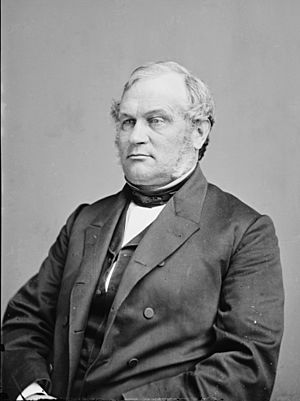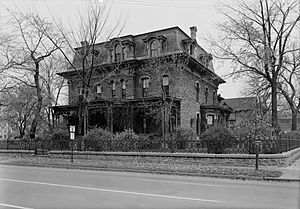Alexander Ramsey facts for kids
Quick facts for kids
Alexander Ramsey
|
|
|---|---|
 |
|
| 34th United States Secretary of War | |
| In office December 10, 1879 – March 5, 1881 |
|
| President | Rutherford B. Hayes |
| Preceded by | George W. McCrary |
| Succeeded by | Robert Lincoln |
| United States Senator from Minnesota |
|
| In office March 4, 1863 – March 3, 1875 |
|
| Preceded by | Henry Rice |
| Succeeded by | Samuel J. R. McMillan |
| 2nd Governor of Minnesota | |
| In office January 2, 1860 – July 10, 1863 |
|
| Lieutenant | Ignatius L. Donnelly |
| Preceded by | Henry Sibley |
| Succeeded by | Henry Swift |
| 5th Mayor of Saint Paul, Minnesota | |
| In office 1855–1856 |
|
| Preceded by | David Olmsted |
| Succeeded by | George Becker |
| 1st Governor of Minnesota Territory | |
| In office June 1, 1849 – May 15, 1853 |
|
| Appointed by | Zachary Taylor |
| Preceded by | Position established |
| Succeeded by | Willis A. Gorman |
| Member of the U.S. House of Representatives from Pennsylvania's 14th district |
|
| In office March 4, 1843 – March 3, 1847 |
|
| Preceded by | James Irvin |
| Succeeded by | George Eckert |
| Personal details | |
| Born | September 8, 1815 Hummelstown, Pennsylvania, U.S. |
| Died | April 22, 1903 (aged 87) St. Paul, Minnesota, U.S. |
| Political party | Whig (Before 1857) Republican (1857—1903) |
| Spouse | Anna Jenks |
| Education | Lafayette College Dickinson School of Law |
| Signature | |
Alexander Ramsey (born September 8, 1815 – died April 22, 1903) was an important American politician. He held many different jobs in government from the 1840s to the 1880s. He was a member of the Whig and later the Republican parties. Ramsey was also the very first Governor of the Minnesota Territory.
Contents
Early Life and Family Background
Alexander Ramsey was born in Hummelstown, Pennsylvania, on September 8, 1815. He was the oldest of five children. His father, Thomas Ramsey, was a blacksmith, a person who works with metal. Sadly, his father died when Alexander was young.
After his family separated, Alexander went to live with his uncle in Harrisburg. His brother, Justus Cornelius Ramsey, also became a politician in Minnesota.
Alexander first studied carpentry at Lafayette College. He later studied law and became a lawyer in Pennsylvania in 1839.
In 1844, Ramsey married Anna Earl Jenks. They had three children together. Only one daughter, Marion, lived to be an adult.
Alexander Ramsey's Political Career
Alexander Ramsey began his political career in Pennsylvania. He was elected to the U.S. House of Representatives as a Whig. He served in Congress from 1843 to 1847.
After that, he became the first Governor of the Minnesota Territory. He held this position from 1849 to 1853. In 1855, he was elected mayor of St. Paul, Minnesota.
Ramsey later became the second Governor of Minnesota after it became a state. He served as governor from 1860 to 1863. During the American Civil War, he was the first governor to offer troops to President Abraham Lincoln. He was in Washington, D.C., when the war started. He quickly went to the White House to offer Minnesota's help.
He left the governor's job to become a U.S. Senator in 1863. He was a Republican Senator and was re-elected in 1869. He served in the Senate until 1875. As a Senator, he supported the Radical Republicans. This group wanted to strongly continue the Civil War and rebuild the Southern states. He also voted to remove President Andrew Johnson from office.
During his time as governor, a conflict known as the Dakota War of 1862 occurred. This conflict involved land disputes and disagreements over treaties between the Dakota people and American settlers. Ramsey and other officials were involved in these land matters. Following the conflict, Ramsey stated that the Dakota people should be removed from Minnesota.
From 1879 to 1881, Ramsey served as United States Secretary of War. This meant he was in charge of the U.S. Army under President Rutherford B. Hayes. Later, from 1882 to 1886, he was a commissioner in Utah. He helped enforce a law called the Edmunds Act. This law made it illegal for certain groups to vote or hold office. Ramsey was part of a Supreme Court case, Murphy v. Ramsey, which confirmed that the government could deny voting rights in these specific situations.
Ramsey's Legacy
Many places and things are named after Alexander Ramsey.
- His old home, the Alexander Ramsey House, is now a museum. The Minnesota Historical Society takes care of it. It was added to the National Register of Historic Places in 1969.
Some places named after him include:
- Ramsey County, Minnesota
- Ramsey County, North Dakota
- The city of Ramsey, Minnesota
- The city of Ramsey, Illinois
- Alexander Ramsey Park in Redwood Falls, Minnesota, which is the biggest city park in Minnesota.
- Ramsey Park in Stillwater, Minnesota
- An elementary school in Montevideo, Minnesota, is named Alexander Ramsey Elementary School.
Some schools that were once named after him have changed their names. Hidden River Middle School in Saint Paul, Minnesota and Justice Page Middle School in Minneapolis, Minnesota were formerly named after Alexander Ramsey.
A ship launched in 1942 was also named after him, the SS Alexander Ramsey.
See also
 In Spanish: Alexander Ramsey para niños
In Spanish: Alexander Ramsey para niños


